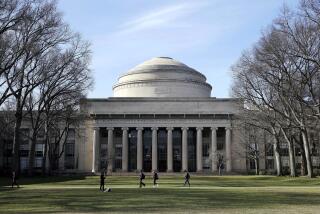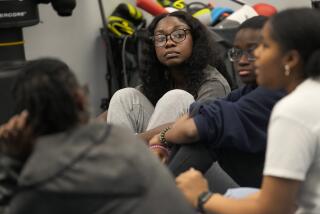For black students at Texas, Supreme Court remarks are a burden added

Black students at the university, and particularly those in the sciences, found themselves on the defensive again this week after Supreme Court Justice Antonin Scalia questioned whether African American students were well served by being admitted to
As a chemical engineering major who aced high school science courses and was a regional leader in the National Society of Black Engineers, becoming a physics tutor at the University of Texas at Austin came easily to Claiborne Jones.
But students never seemed to seek his help.
“People I was tutoring would blow me off, as if I didn’t know what I was talking about, and ask someone else if it was correct,” Jones, 21, said.
Black students at the university, particularly in the sciences, found themselves on the defensive again last week after Justice Antonin Scalia, during arguments before the U.S. Supreme Court, questioned whether admitting more black students would benefit them or the university. The case before the court, Fisher vs. University of Texas at Austin, is likely to affect the future of affirmative action nationwide.
Abigail Fisher, who is white, originally filed the lawsuit claiming she was rejected by the school under a race-based admission system. During Wednesday’s session, Scalia questioned whether affirmative action truly helps black students.
“There are some who contend that it does not benefit African Americans to get them into the University of Texas, where they do not do well, as opposed to having them go to a less-advanced school, a slower-track school where they do well,” Scalia said. “I’m just not impressed by the fact the University of Texas may have fewer [black students]. Maybe it ought to have fewer.”
Scalia’s remarks stunned UT Austin senior David McDonald, who was sitting in the gallery with another member of the university’s Black Student Alliance, which filed a brief in the case.
“It really caught me off guard. I was looking around to see if anybody else was reacting the way I was,” McDonald said, and although the gallery was silent, he said his classmate and others looked as shocked as he was.
“We’re engaged in research, studying abroad, people are graduating, going on to become doctors and professors. Black students do deserve to be at UT, and we are excelling,” said McDonald, 22, who is majoring in education and black studies. “Everyone kind of felt attacked by his remarks.”
Sitting next to him in the gallery was Christle Nwora, 21, of Dallas, a fellow senior pre-med major who also took note when Chief Justice John G. Roberts Jr. asked why diversity matters in science classes.
“It’s this contact idea,” Nwora said Saturday, taking a break from studying for a cell biology final next week to share breakfast near campus with McDonald, who has a physics final coming up. “The more contact I have with people who are different from me, the more I learn about them” and can work with them in the future, Nwora said.
The university is among the country’s largest, with more than 39,000 undergraduate and 11,000 graduate students. The student body this fall was about 45% white, 20% Latino, 17% Asian, 10% foreign and 4% black. The proportion of black students has remained relatively flat in recent years, up slightly from about 3% in 2000. It was slightly higher for the College of Natural Sciences freshman class this year, about 5%.
UT Austin has been the focus of other lawsuits, including the landmark 1950 Supreme Court case Sweatt vs. Painter, involving the law school, that helped overturn the “separate but equal” doctrine of segregated schools.
“We’re constantly in the public discourse on race and colleges,” Nwora said.
Scalia’s comments provoked a swift outcry from African American UT students and alumni.
They started the Twitter hashtag #StayMadAbby — referring to the plaintiff — including their graduation photos, credentials, references to their advanced degrees and the school’s trademark burnt orange Longhorn logo.
At the Austin campus, some African American students said Scalia’s comments underlined their ongoing challenge to try to feel safe and belong, especially in the sciences.
Jones recalled his first night on campus, when he and some friends were walking down the main drag and a group of guys in a passing van yelled racial expletives.
“That wasn’t even the worst thing that happened that year: Students were getting bleach-ballooned,” he said, referring to a series of attacks in which water balloons filled with bleach were hurled at black students, prompting protests. At one point, Jones said, a white friend insisted on walking him home for his own safety.
The discomfort was felt not only by students from low-income neighborhoods and urban schools, like Jones, but also those whose parents were wealthier and had earned advanced degrees.
Camryn Burkins, 20, of Houston, was encouraged to attend engineering school at UT Austin by her father, a mechanical engineer, and her mother, who has a doctorate in education — both UT Austin graduates who met as students. She had applied to UT Austin as a safety school but decided to attend even after being accepted by some of her top choices: Amherst, Carlton, Middlebury and Vanderbilt (she was not accepted by some of the Ivy League schools she applied to).
Burkins had always excelled in science, but once she arrived at college, “I started to pick up on the way people would respond to me being an engineering major, like, ‘Well, that’s so hard. Are you sure you want to do that?’ or ‘Well, let me know if that doesn’t work out’ or ‘How’s it going? Are you still in engineering?’ I started to realize not a lot of people expected me to succeed here. And that was jarring.”
In physics class, when it came time to choose lab partners, Burkins said other students assumed she didn’t know what she was doing.
“No one really wants to work with you,” Burkins said, and when they did, they would always double-check her answers.
She responded by tapping into the network for black and minority students in engineering, including the Equal Opportunity In Engineering Program. She joined the National Society of Black Engineers, which offers free tutoring and mentors. Then she became president of the group on campus.
“We try to catch the freshmen early, like, ‘Hey, you’re not alone,’” Burkins said, noting that many are hesitant to ask for help, afraid they will lend credence to those who question whether they are qualified. They often say their professors don’t call on them, or teaching assistants don’t help them, she said.
Burkins is so committed to helping fellow engineering students that even after she recently realized she’s more interested in environmental science, she decided to stick with engineering.
“There are so few black kids in engineering and so many people don’t want me to succeed, I don’t want to prove them right,” she said.
molly.hennessy-fiske@latimes.com
ALSO
Black scientists respond to Scalia’s suggestion that ‘less advanced’ classes are more suitable
Middle-class families, pillar of the American dream, are no longer in the majority, study finds
How Utah quietly made plans to ship coal through California
More to Read
Sign up for Essential California
The most important California stories and recommendations in your inbox every morning.
You may occasionally receive promotional content from the Los Angeles Times.











